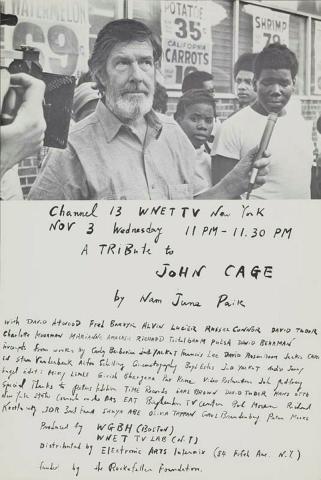Nam June Paik: TV cello
Nam June Paik played a pioneering role in the development of video, new media and multimedia art. Paik made an enormous contribution to sound, performance and multimedia art forms, radically developing and altering the understanding and perception of these media as art. Paik's interest in sound began as a young high school student when he studied music, art history and aesthetics at the University of Tokyo, where he completed a dissertation on the atonal music of Arnold Schoenberg. His contact with John Cage (see Flyer for 'A tribute to John Cage' 1973) in 1958 emerged as a turning point for both their careers. Paik's association with the Fluxus movement began in 1961 in Germany, when he met George Maciunas. During this period Paik performed in numerous Fluxus events across Europe, and formed an important collaborative partnership with cellist Charlotte Moorman during the late 1960s and 1970s. A pioneer of electronic media, Paik's interest and attitude is characterised by his eclectic combination of material, which extends to include sound, found objects, text and the moving image.
TV cello encapsulates Paik's abiding and central interest in sound as an important and distinctive aspect of his visual art practice. Incorporating his characteristic video montages that form the image base for the television monitors, TV cello is an elegant summary of Paik's enduring fascination and exploration of performance, sound and visual art. Paik's collaborations with, and compositions for, cellist Charlotte Moorman (1933–91) throughout their careers are testament to an extremely important creative relationship. Paik met Moorman through the composer Stockhausen in New York in 1964, when she was organising an avant-garde festival of music and performance. Moorman was a classically trained cellist and had been playing since the age of ten. In 1961 she shared an apartment with Japanese artist Yoko Ono and it was through her that Moorman came into contact with New York's avant-garde. After meeting with Paik in 1964, much of their subsequent work was dedicated to each other. It was not until 1973 in Global Groove that Paik first used image sequences and fast-edit techniques that Moorman appeared as a character in a video.
Global Groove opens with the statement: 'This is a glimpse of the video landscape of tomorrow, when you will be able to switch to any television station on the earth, and the TV guide will be as fat as the Manhattan telephone book.' Global Groove was the first work in which Paik's frenetically edited score of images foretold the momentous impact of television, as the most effective electronic communication media to affect the lives of millions of people globally. In TV cello the hallucinatory stream of images first witnessed in Global Groove has been honed to feature Moorman as a central character playing the cello, reading musical scores and nursing a replica of a bomb. Thus, TV cello pays homage to his important creative partner, Moorman, in a work made by the artist late in his artistic life. In the work Paik uses archival material of his performance works from the late 1960s and splices it with iconic imagery of the decades leading into the twenty-first century. The cello, made up of television tubes encased in clear perspex cases revealing the inner working of the six monitors, is activated by a series of poetic imagery in which humour, pleasure and the grotesque are embedded as sequences of familiar, recognisable moments from twentieth century history.
TV cello is a skilful synopsis of Paik's absorption and interpretation of contemporary culture and his concerns. Paik stated his interest in the French anthropologist Claude Levi-Strauss's summation of 'culture is a communication network'; this notion of culture sits at the crux of TV cello, which witnesses Paik's own creative interpretation about technology's place in society. Paik's eternal optimism and playfulness ensure that TV cello maintains a strong current of humour and vitality.1
Endnote
- Nam June Paik, 'Media planning for the Postindustrial society', in The Electronic Super Highway: Travels with Nam June Paik. Fort Lauderdale Museum of Art, United States, 1994, p.47.
Connected objects

TV cello 2000
- PAIK, Nam June - Creator

Global groove 1973
- PAIK, Nam June - Creator
Metadata, copyright and sharing information
About this story
- Subject
